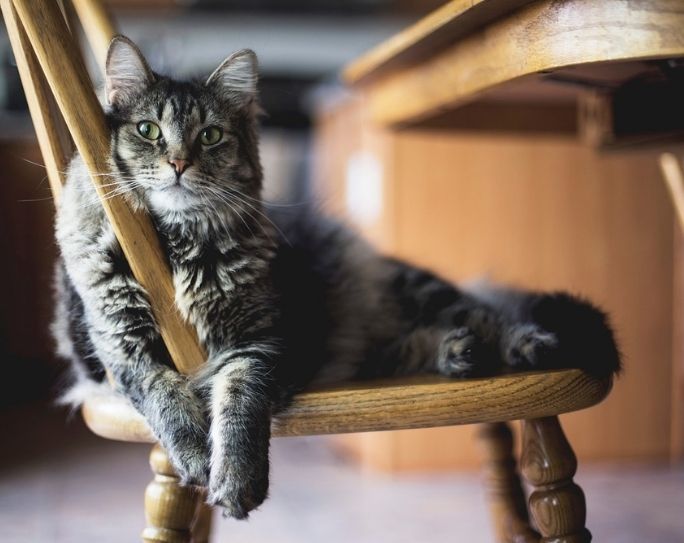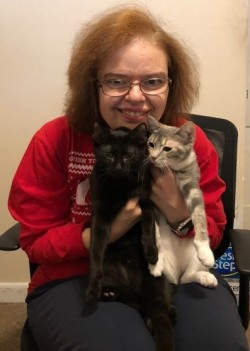Keeping your indoor pets safe from household hazards
By Debbie De Louise | October 25, 2019

Most people know that outdoor pets face many dangers. They can be hit by a car, exposed to various diseases, unprotected from extreme weather, and harmed in other ways. But indoor pets also face hazards. These include serious reactions and sometimes death from ingesting toxic products, plants, food, and miscellaneous household items including medications.
Hazards of Household Cleaners
According to Amy Shojai, a nationally known pet care expert and the author of over 30 pet books including The First Aid Companion for Dogs & Cats, “Bleach, drain cleaner and toilet bowl products, phenol disinfectants like Lysol and Pine-sol (they often have “-sol” in the name), and petroleum products such as gasoline, kerosene, or turpentine are all highly toxic to pets.” Although these items are dangerous to both cats and dogs, Shojai said that felines are more sensitive to phenol products.
Shojai recommends keeping these products out of “paw-reach.” She stores cleaners under the sink but says that they could also be kept in a separate closet with a latched door. “When using these cleaners, ensure your pets are safely confined in another room. Don't allow them access to the cleaned area until after the product has thoroughly dried. At my house, we make a habit of ALWAYS closing the lid to the commode so neither the cat nor dog ever has access to the toilet as a 'drinking fountain.’ While dogs explore more by sniffing and tasting even noxious products, cats may simply walk across a treated floor, lick their paws clean, and end up poisoned.”
Debbie Nearenberg, DVM, relates an experience she had where a dog was brought to her that had eaten a Clorox wipe. Although it turned out that the wipe wasn’t toxic because it didn’t contain bleach, she had to induce vomiting to avoid the wipe causing an obstruction. Many other common products can cause obstructions such as string, thread, rubber bands, and dental floss. My brother’s cat, when it was young, ate dental floss and required surgery. He survived and lived a long life, although the surgery put my brother back quite a bit of money.
Ingestion or contact with toxic products causes different signs of illness. Nearenberg says that a pet may drool, appear weak or wobbly, vomit, or exhibit other abnormal behavior. Shojai warns that if a dangerous product is spilled on a pet, especially a phenol product that is absorbed through the skin and can lead to coma and death, the pet owner shouldn’t induce vomiting but should flush the contact area with water for ten minutes. If bleach or another acid is ingested, she said you could give the pet two teaspoons of milk of magnesia. For alkaline poisons like drain cleaner, Shojai recommends six tablespoons of a 50/50 mix of water and lemon juice or vinegar to neutralize the poison. If the pet has ingested a Petroleum product, it will vomit, have difficulty breathing, and may shake and have seizures. If you can’t bring it to a vet or emergency pet clinic within thirty minutes, Shojai suggests giving the pet one to two ounces of mineral, olive, or vegetable oil by mouth. The most important thing if a pet has ingested or been exposed to a toxic household product is to bring him to a vet or emergency veterinary clinic as soon as possible.
Although keeping unsafe household products away from pets is the best way to avoid illness or death, there are also alternative products that a pet owner might consider. Shojai named Simple Green as a safer cleaning brand. Nearenberg also said Febreze is safe for pets, but she warned that many pet products labelled all-natural aren’t nontoxic. For instance, she’s seen many cases of people bringing in cats treated with flea and tick repellent containing essential oils, particularly clove oil, which she says is extremely toxic to pets.
Pets and Plant Dangers
Pet owners may also keep plants in their homes that are poisonous to animals. Cats like to chew on plant leaves. During December, people decorate with Poinsettias, while Easter lilies are popular in the spring. Both are toxic to pets. I have a lemon plant that’s a patio plant, but I keep it indoors when it’s cold outside. Last winter, when my cat Hermione was still a kitten, she got into the room with the lemon plant. I caught her before she chewed on the plant but wasn’t sure if she’d nibbled a leaf that had fallen on the ground. I contacted my vet who told me that a dry leaf isn’t as dangerous as a fresh one. She advised me to observe Hermione for any signs of poisoning such as vomiting which she thankfully didn’t show.
Author and blogger Denise Lee Branco doesn’t keep plants in her house, although she enjoys their beauty. “I’ve chosen not to have flowers or plants in my house so my indoor-only cats are safe,” she said, “But I planted a rose garden and flowering shrubs so I can look out my windows and have the next best thing.” She also gives her cats wheatgrass to satisfy their need to nibble greenery. She keeps it in her refrigerator and clips a little at a time for them, so they won’t eat too much and vomit.
Cat author Mollie Hunt also faced problems with plants and her cat Tyler. When she inherited some plants from her mother, she said that she “tried many things to keep them—and Tyler—safe, including draping them with gauze and spraying them with lemon juice, but it never really worked. The only sure way was to set the plants out of cat-reach, so that’s what I did. But one that he shouldn’t have been able to get to, an Aloe Vera, became his favorite when he figured out how to climb up to it. I ended up giving that one away to a home without cats.”
Hunt then noticed that Tyler seemed to like plant stems more than their leaves. She purchased honeysuckle sticks for him and also planted a pot of cat grass and catnip mix called “Pet Grazing Garden.” That seemed to do the trick, or maybe Tyler just became bored with going after plants because he stopped except for a Hoya that Hunt says he only seems to attack when someone’s watching to get their attention.
Food Dangers
Another danger to indoor pets is food that, while eaten by people, can be toxic to animals. Most people know that chocolate is dangerous to pets. However, they may not be aware that other foods can cause digestive upset or even death such as raisins and grapes which Nearenberg states can cause kidney failure in both cats and dogs. Xylitol, a chemical in sugar-free gum, is also a no-no for pets.
Jeanne Kudich, blogger of Randomfelines.com, had a close call with M & M’s and her cats Tim and Tom. “When I first adopted Tim and Tom, Tim got on the counter, opened a bag of M & M’s and knocked them to the floor for his brother to eat (he only got 3 or 4).” Luckily, Tom was okay.
Other Household Hazards
Common household items also pose dangers to pets including medications, office supplies, holiday and other decorations, and miscellaneous products. Kudich recalls a scary yet funny incident. “I caught Tom crunching something. Turns out it was a birth control pill. He was fine, and the vet got a good laugh.” Nearenberg pointed out that aspirin and Tylenol are deadly to cats while not as toxic to dogs but shouldn’t be administered to either animal.
When I first got married and lived in an apartment, I had a cat named Floppy. We’d put up a small tree for Christmas, and he kept knocking it down. One day, I caught him with something in his mouth. It turned out to be an ornament hook. Luckily, I got it out of his mouth before he swallowed it. After that, I only used ribbon to hang ornaments, but I made sure he didn’t get those either. More recently, I found some staples on my kitchen floor near where I feed my three cats. They weren’t easy to see, but I picked them all up. I then found the source—my kitchen drawer where I’d been keeping a box of staples. I’ve since moved them inside a closed drawer in my office. I’m still on the lookout for dangerous items. Whenever I break a glass in the kitchen, I vacuum up the small shards and also go over the area with a wet cloth for fear the cats will pick up the small pieces in their paws or I or one of my other family members will get them in our feet. Small batteries, such as the button-cell type, are toxic if swallowed by a curious pet. Because of their size and shape, cats find them appealing to play with.
Another incident that occurred recently was when I accidentally sprayed our cat Harry with a mixture of essential oils and water. I needed to get him off the top of my closet, so I grabbed a spray bottle I thought was full of water. I later found out that my teenage daughter had filled it with an essential oil mixture. Some essential oils absorbed through the skin are lethal to pets. I wiped Harry off with a wet cloth as soon as he came down from the closet and thanked goodness that he seemed fine afterwards.
Besides dangerous objects, pet owners need to make sure they close or turn off appliances after they’ve used them for their own safety and their pets. Cats are inquisitive by nature and like to go inside things especially warm places. There have been terrible accidents when cats have gotten into an open washing machine or dryer. You also must be careful when opening and closing drawers and doors. When I was putting away clothes, my cat Harry almost got his paw stuck in the drawer when I went to close it. I’ve also almost closed a door on some of my cats’ tails not to mention stepping on their feet, luckily lightly and with slippers.
Like babies and young children, you can never be too safe with pets in the house. Nearenberg recommends locking things away in cabinets and keeping things off counters. My cat Harry, as a kitten, went through a period of jumping on my kitchen counter and even sitting in my sink. My cat, Floppy, used to jump on my stove, so I had to put child-proof locks around the knobs.
An interesting side note that Nearenberg mentioned was that people have brought pets to her who’d consumed alcohol and pot. She mentioned that there was a 60 percent increase in dogs intoxicated from marijuana in Colorado when it became legal.
Below are links to articles about toxic plants, foods, and products. If you’re not sure what is safe for your pet, use caution and check with your vet.
https://www.proflowers.com/blog/poisonous-plants
https://www.aspca.org/pet-care/animal-poison-control/people-foods-avoid-feeding-your-pets
https://www.americanhumane.org/blog/the-4-surprising-pet-poisons-lurking-in-your-home
https://www.aspca.org/pet-care/animal-poison-control/poisonous-household-products
 About Debbie De Louise
About Debbie De Louise
Debbie De Louise is a reference librarian at a public library. She is a member of the Cat Writers’ Association, The Long Island Author’s Group, Sisters-in-Crime, and International Thriller Writers and the author of seven novels including the four books of her Cobble Cove cozy mystery series. Her latest release, Sea Scope, is a psychological mystery. She lives on Long Island with her husband, daughter, and three cats. Check out her website at https://debbiedelouise.com and follow her on Facebook and Twitter (@deblibrarian).







Comments
No comments.